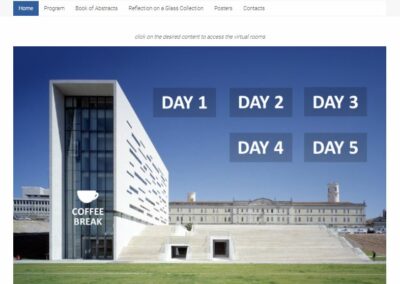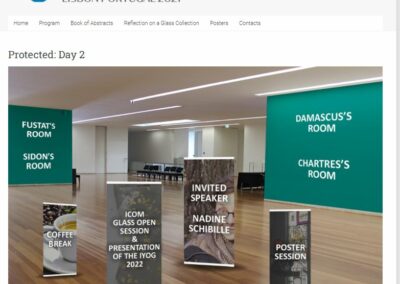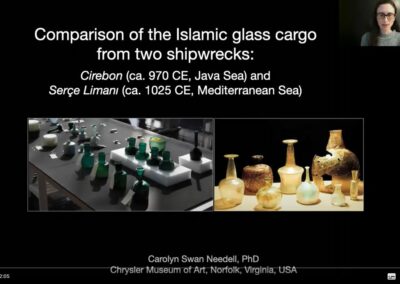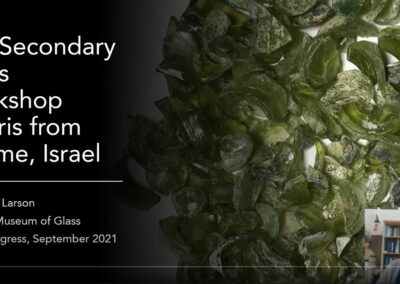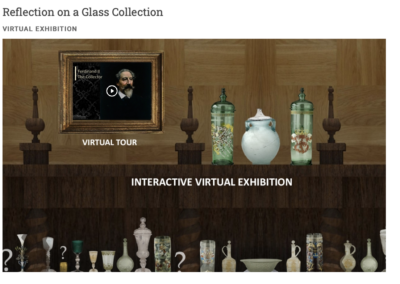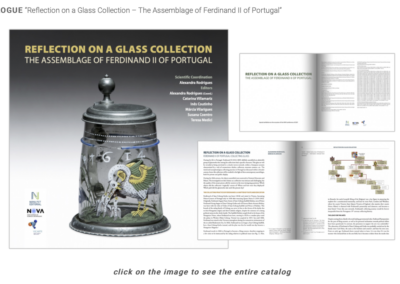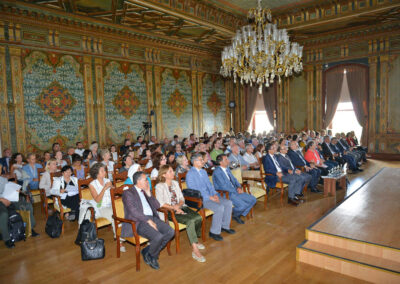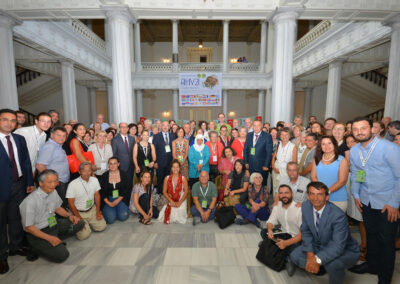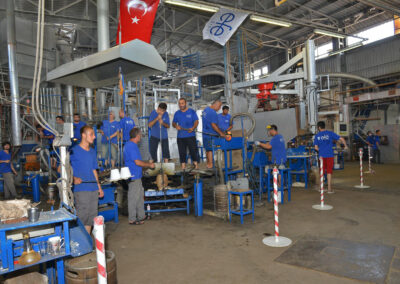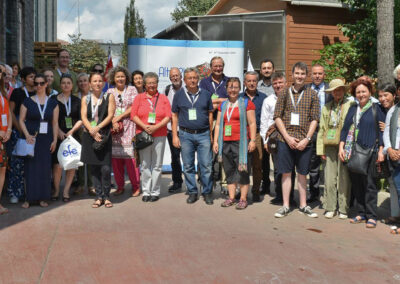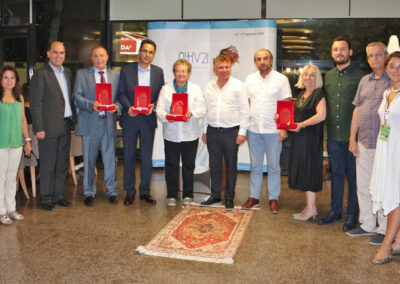Former Congresses
2021
22th Congress of the AIHV
13 – 17 September 2021, Lisbon, Portugal
Still in a COVID-19 pandemic environment, the AIHV board together with the Research and Development Unit VICARTE and the Department of Conservation and Restoration, both from the NOVA School of Science and Technology in Portugal, decided to embrace the challenge to pursue with the 22nd International Conference of AIHV.
In a full virtual mode, the 5 conference days were considered a successful endeavor. Keeping the traditional parallel sessions, the conference had more than 150 participants from 29 different countries.
The conference featured 76 oral presentations and 69 poster presentations.
Virtual tours to museums were organized and live glass working demonstrations were assured by the Glass Studio from Corning and by VICARTE studio.
Also, a special exhibition was put together with the respective catalogue to offer our participants a closer feeling of an in-presence conference. ICOM Glass IC joined up with the AIHV22 International conference. On Tuesday, 14th September afternoon, an ICOM Glass Open Session was held. The session started with two talks. Emma Lochery, the producer and curator of two new museums related to glass that opened their doors in Porto, gave guided virtual tours of the private collection of Adrian Bridge, CEO of Taylor’s Port, and of the Museu do Vitral, the Portugal’s first museum dedicated to stained glass, while Teresa Almeida introduced the attendants to the very rich contemporary stained glass heritage preserved in religious and civil buildings located in the north of Portugal.
2018
21th Congress of the AIHV
3 – 7 September 2018, Istanbul, Türkiye
The 21st congress of the Association Internationale pour l’Histoire du Verre took place in Istanbul. Our Turkish colleagues did a great job in organizing everything at it’s best and they welcomed us very warmly. An opening ceremony with many journalists from newspapers and television never happened before. The same was true for the farewell party with special gifts to the organizers and even for me as former president of the association. The offered meals were always rich and very tasty, I left Turkey with at least two kilos more and I think, so did others. We felt like a big family.
The communications and posters were very interesting, with the focus on antique, byzantine and Islamic glass. That won’t mean we will neglect the medieval and modern glass, but the region has more antique, byzantine and Islamic sites and finds, than medieval and modern.
On Wednesday we had the chance to visit EFE-Glasshouse, a big company, who supported the congress. EFE is producing f. ex. special glass vessels and lamps for Turkey and abroad.
The post congress tour was guided by Dr. Özgümüs, a well-known specialist of the byzantine period. He explained the underground excavations of Istanbul with great enthusiasm. It’s amazing how many cisterns there are preserved, some under hotels or restaurants, just some columns in boutiques and so on. The second day we were guided to churches with lovely mosaics and wall paintings, to mosques, which had been churches and to the highlights as Hagia Sophia and the Blue Mosque. We visited the Topkapi Palace with amazingly big trees in the garden, with an exhibition on Chinese porcelain and last but not least, one of the most famous cisterns near Hagia Sophia. The former Circus Maximus was crossed several times and in general, we walked quite a lot these two days. The walk gave us the opportunity to see a lot of nice and interesting places in the city.
The 21st congress in Istanbul was a great success. We all know, that the organization was not so easy and several times during the three years we were in doubt, whether the congress could take place in Turkey or not. Unfortunately, the Saturday of our post-congress tour was a very, very sad day, as our member Yoko Shindo from Japan had a serious traffic accident and passed away after some days in hospital. We all miss her; she was member for a long time, contributed to the work of our Executive Committee and did a lot in the field of glass research. We share the grief of her family and friends.
2015
20th Congress of the AIHV
7 – 11 September 2015, Fribourg/Romont, Switzerland
More than 250 researchers and glass specialists from 32 countries participated in the 20th Congress of the International Association for the History of Glass (AIHV) in Fribourg and Romont.
The organisers would like to thank all those who enriched the congress by contributing oral or poster presentations. Thanks are also due to the chairpersons for ensuring that the sessions ran smoothly and for stimulating discussion. Without the support of a great number of helpers, partners and sponsors, the congress would not have been possible. We also want to thank all participants for their interest and for helping create such an agreeable atmosphere at the congress. A very big THANK YOU to all of you for contributing to the success of this exciting and fruitful week!

2012
19th Congress of the AIHV
17 – 21 September 2012, Piran, Slovenia
The Congress began with a reception on Sunday, September 16, at Trevisini Palace in the heart of Piran, featuring an exhibition by Slovenian glass artists Marko Jezernik and Zvonka Pozun. The official opening took place on Monday morning at the Bernardin Congress Center, followed by the first paper session at Trevisini Palace.
Over the next four days, a total of 65 papers and 73 posters were presented, with sessions each morning and additional sessions on Monday, Wednesday, and Friday afternoons.
Participants enjoyed a walking tour of Piran on Monday evening and traveled to Ljubljana on Tuesday afternoon to visit glass exhibits at the National Museum of Slovenia and the Slovene Ethnological Museum.
On Thursday, they visited Aquileia, an extensive Roman archaeological site. On Friday afternoon, the General Assembly convened at the Bernardin Congress Center, where Sylvia Fünfschilling was elected as the new president, Anastassios Antonaras as the new General Secretary, and Karol Wight and Maria Grazia Diani joined the Board, along with outgoing president Mari-Dominique Nenna. Later that evening, a closing reception and dinner were held on the terrace of the Hotel Histrion.
The Post-Congress Tour took place on the weekend, with about 45 participants departing Piran at 7 am for Croatia, first visiting the Museum of Lower Carniola in Novo Mesto, then continuing to Zagreb to explore glass collections at the Archaeological Museum, the Mimara Museum, and the Museum of Applied Arts and Crafts. The Mimara Museum features a diverse array of decorative arts from a private collection. In the late afternoon, the group visited the Biograd Museum, showcasing Venetian glass from the Gnalic shipwreck believed to date back to the 1580s.
On Sunday, the group traveled from Biograd to Split, where they toured the Archaeological Museum’s exhibition “Aristeas and Ennion in Dalmatia” and explored the nearby remains of Diocletian’s Palace and the church tower where he is buried. The final stop was the Museum of Ancient Glass in Zadar, known for its impressive collection and informative labels in both English and Croatian, where the museum hosted a reception for the group. Despite the tour being just two days long, participants were fortunate to experience a wide variety of glass in Croatian museums.
2009
18th Congress of the AIHV
20 – 25 September 2009, Thessaloniki, Greece
The opening reception/dinner on Sunday took place at the Archaeological Museum which also installed an excellent exhibition of ancient glass called “COSMOS.” A guided bus tour of the most important sites was available for participants so that they could become familiar with the layout of the city. The Monday-Friday paper sessions took place at the Museum of Byzantine Culture. There were a total of 157 attendees, from 35 countries.
The aim of the triennial congresses of AIHV is to bring together archaeologists, art-historians, glass collectors and technologists as well as museum curators to discuss all aspects of glass history through the ages as well as the technology of glass-making, glass working and glass decorative art. Despina Ignatiadou from the Archaeological Museum of Thessaloniki and Anastasios Antonaras from the Museum of Byzantine Culture were the overall organizers. The General Assembly of AIHV was held on Friday, and presided over by Dr. Marie-Dominique Nenna, the president of AIHV.
There were 32 sessions in 16 time slots, spread over five days with a total of 77 papers presented. The sessions were chronological, with one set focusing on classical and earlier glass and the other sessions on Byzantine and later glass. There were also 50 posters, presented in sessions on Tuesday and Thursday. On Wednesday afternoon, walking tours of the city were offered, concentrating on classical sites, Byzantine sites and Ottoman and Jewish sites. A boat trip around the Thermaikos Gulf was offered to participants on Tuesday evening and a Winery visit on Thursday evening. The final dinner/reception was held Friday evening at a park belonging to the local government.
Following the close of the Congress, three 1 day trips, to different parts of Macedonia were organized: to Verginia, Dion and Pikrolimni; to Philippi and Amphipolis, and a cruise to Mt. Athos.
2006
17th Congress of the AIHV
4 – 8 September 2006, Antwerp, Belgium
The 17th Congress of the International Association for the History of Glass (AIHV) was held at the invitation of Verre-Glas, the Belgian National Committee of AIHV. There were 196 members registered. The Congress opened on Monday with a talk by the President, Marie-Dominique Nenna, “Fifty Years of AIHV”. Dr. Nenna also introduced Madame Joseph Philippe, the widow of the founder of AIHV, who was in attendance.
The aim of the triennial congresses of AIHV is to bring together archaeologists, art-historians, glass collectors and glass technologists, and museum curators to discuss the socio-economic and socio-cultural aspects of glass use throughout history, as well as the development of the technology of glass-making, glass working and glass decorative art throughout history. The Conference was held in the “Elzenveld” conference center, in the center of Antwerp and was also sponsored by the universities of Antwerp, Leuven and Brussels and the department of excavations of the City of Antwerp. Professor Koen Janssens, of the University of Antwerp was Chairman of the Organizing Committee.
There were 14 sessions on different aspects of glass history, each with a keynote speech and several papers, a total of 84 talks. Forty poster contributions were on display throughout the Congress. An elegant opening reception was held at the Antwerp Town Hall on Monday evening, and after the General Meeting on Tuesday afternoon, participants were invited to an organ concert at the Cathedral of Our Lady in the center of Antwerp. The Cathedral has beautiful stained glass windows. On Wednesday afternoon, there were several themed tours for attendees (one focusing on the painter, Peter Paul Rubens, another called the Golden Age of Antwerp and one to the diamond workshops, for example) followed by the Congress Dinner in the Marble Hall of the Antwerp Zoological Gardens, and on Thursday, Congress participants were invited to a preview of an exhibit of Contemporary Belgian Glass at the Kolveniershof. The meeting closed at noon on Friday, September 8 and was followed by a Post-Congress tour, September 9-13, to museums and private collections in Belgium and Luxembourg.

